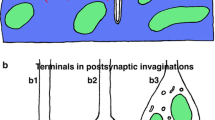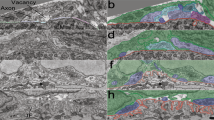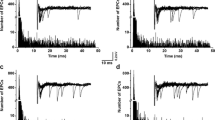Abstract
The extent of quantal transmitter release from single sites of synaptic vesicle accumulations along the length of motor-nerve terminal branches at the amphibian neuromuscular junction has been investigated. Such a determination involves development of a model for the generation of quantal potential fields at single styryl-dye stained sites along the length of a branch. Successful testing and application of this model indicates that the extent of quantal release at a dye-stained site is proportional to the total length of active zone at the site.
The stability of these sites and of their ensheathing terminal Schwann cell processes was also investigated. Following simultaneous injection of the terminal Schwann cell and nerve terminal with different fluorescent dyes, terminal branches were observed to show dynamic changes in their length, with these occurring in relatively short periods of hours or less. Redistribution of styryl dye stained sites at the ends of branches also occurred in such short periods of time. These were accompanied by changes in the configuration of terminal Schwann cells, which generally occurred prior to changes in the length of nerve terminal branches.
Similar content being viewed by others
References
ALTMAN, K. W. & PLONSEY, R. (1988) Development of a model for point source electrical fibre bundle stimulation. Medical Biology Engineering Computing 26, 46–475.
ANZIL, A. P., BIESER, A. & WWERNIG, A. (1984) Light and electron microscope identification of nerve terminal sprouting and retraction in normal adult frog muscle. Journal of Physiology 350, 39–399.
BALICE-GORDON, R. J. & LICHTMAN, J. W. (1990) In vivo visualization of the growth of pre-and postsynaptic elements of neuromuscular junctions in the mouse. Journal of Neuroscience 10, 89–908.
BENNETT, M. R. (1996) Neuromuscular transmission at an active zone: The secretosome hypothesis. Journal of Neurocytology 78, 86–891.
BENNETT, M. R., FARNELL, L. & GIBSON, W. G. (1999) Cable analysis of a motor—nerve terminal branch in a volume conductor. Bulletin of Mathematical Biology 61, –17.
BENNETT, M. R., FARNELL, L. & GIBSON, W. G. (2000a) The probability of quantal secretion within an array of calcium channels of an active zone. Biophysical Journal 78, 222–2240.
BENNETT, M. R., FARNELL, L., GIBSON, W. G., MACLEOD, G. T. & DICKENS, P. (2000b) Quantal potential fields around active zones of amphibian motor—nerve terminals. Biophysical Journal 78, 110–1118.
BENNETT, M. R., JONES, P. & LAVIDIS, N. (1986) Transmitter secretion varies between visualized release sites at amphibian neuromuscular junctions. Neuroscience Letters 65, 31–315.
BENNETT, M. R. & LAVIDIS, N. A. (1979) The effect of calcium ions on the secretion of quanta evoked by an impulse at nerve terminal release sites. Journal of General Physiology 74, 42–456.
BENNETT, M. R. & LAVIDIS, N. A. (1982) Variation in quantal secretion at different release sites along developing and mature motor terminal branches. Brain Research 281, –9.
BENNETT, M. R. & LAVIDIS, N. A. (1989) The probability of quantal secretion at release sites in different calcium concentrations in toad (Bufo marinus) muscle. Journal of Physiology 418, 21–233.
BETZ, W. J., MAYO, F. & BEWICK, G. S. (1992) Activity dependent fluorescent staining and destaining of living vertebrate motor nerve terminals. Journal of Neuroscience 12, 36–375.
BIRKS, R., HUXLEY, H. E. & KATZ, B. (1960) The fine structure of the neuromuscular junction of the frog. Journal of Physiology 150, 14–168.
BORST, J. G. & SAKMANN, B. (1996) Calcium influx and transmitter release in a fast CNS synapse. Nature 383, 43–434.
CHEN, L. L., FOLSOM, D. B. & KO, C. P. (1991) The remodeling of synaptic extracellular matrix and its dynamic relationship with nerve terminals at living frog neuromuscular junctions. Journal of Neuroscience 11, 292–2930.
COUTEAUX, R. & PECOT-DECHAVASSINE, M. (1970) Synaptic vesicles and pouches at the level of "active Synapse formation at mature terminals 471 zones'' of the neuromuscular junction. CR Academy of Sciences Hebd Seances Academy of Sciences 271, 234–2349.
DEL CASTILLO, J. & KATZ, B. (1954) Quantal components of the end-plate potential. Journal of Physiology (London) 124, 56–573.
DEL CASTILLO, J. & KATZ, B. (1956) Localization of active spots within the neuromuscular junction of the frog. Journal of Physiology (London) 132, 63–649.
DICKENS, P. A., HILL, P. & BENNETT, M. R. (2003) Schwann cell dynamics with respect to newly formed motor—nerve terminal branches on mature (Bufo marinus) muscle fibers. Journal of Neurocytology 32(4), 38–392.
DREYER, F., PEPER, K., AKERT, K., SANDRI, C. & MOOR, H. (1973) Ultrastructure of the "active zone'' in the frog neuromuscular junction. Brain Research 62, 37–380.
DUDEL, J. (1984) Control of quantal transmitter release at frog's motor nerve terminals. I. Dependence on amplitude and duration of depolarization. Pflugers Archivs 402, 22–234.
DUDEL, J., PARNAS, I. & PARNAS, H. (1993) Spatial facilitation and depression within one motor nerve terminal of frogs. Journal of Physiology 461, 11–131.
EISENBERG, R. S. & JOHNSON, R. S. (1970) Three dimensional electrical field problems in physiology. Progress in Biophysical Molecular Biology 20, –65.
ENGEL, E. V., BARCILON, V. & EISENBERG, R. S. (1972) The interpretation of current-voltage relations recorded from a spherical cell with a microelectrode. Biophysical Journal 12, 38–403.
ENGERT, F. & BONHOEFFER, T. (1999) Dendritic spine changes associated with hippocampal long-term synaptic plasticity. Nature 399, 6–70.
FATT, P. & KATZ, B. (1952) Spontaneous subthreshold activity at motor—nerve endings. Journal of Physiology (London) 117, 10–128.
FERTUCK, H. C. & SALPETER, M. M. (1976) Quantitation of junctional and extrajunctional acetylcholine receptors by electron microscope autoradiography after 125I-alphabungarotoxin binding at mouse neuromuscular junctions. Journal of Cell Biology 69, 14–158.
GYDIKOV, A., KOSSEV, A., TRAYANOVA, N. & STEPHANOVA, D. (1990) Electrotonic potentials of myelinated nerve fibers. Electromyographic Clinical Neurophysiology 30, 4–51.
HARRIS, L. W. & PURVES, D. (1989) Rapid remodeling of sensory endings in the corneas of living mice. Journal of Neuroscience 9, 221–2214.
HENKEL, A. W., LUBKE, J. & BETZ, J. W. (1996) FM1-43 dye ultrastructural localization in and release from frog nerve terminals. Proceedings of the National Academy of Sciences USA 93, 191–1923.
HERRERA, A. A., BANNER, L. R. & NAGAYA, N. (1990) Repeated, in vivo observation of frog neuromuscular junctions: Remodelling involves concurrent growth and retraction. Journal of Neurocytology 19, 8–99.
HEUSER, J. E. & REESE, T. S. (1977) Structure of the synapse. In Handbook of Physiology. The Nervous System. Cellular Biology of Neurons. Bethesda, MD: American Journal of the Physiological Society. Section 1, vol. I, pp. 26–294.
HEUSER, J. E., REESE, T. S., DENNIS, M. J., JAN, Y., JAN, L. & EVANS, L. (1979) Synaptic vesicle exocytosis captured by quick freezing and correlated with quantal transmitter release. Journal of Cell Biology 81, 27–300.
HEUSER, J. E., REESE, T. S. & ROBBINS, N. (1974) Functional changes in frog neuromuscular junctions studied with freeze-fracture. Journal of Neurocytology 3, 10–131.
HILL, R. R. & ROBBINS, N. (1991) Mode of enlargement of young mouse neuromuscular junctions observed repeatedly in vivo with visualization of pre-and postsynaptic borders. Journal of Neurocytology 20, 18–194.
HODGKIN, A. L. & RUSHTON, W. A. H. (1946) The electrical constants of a crustacean nerve fibre. Proceedings of the Royal Society London, Series B, Biological Sciences 133, 44–479.
JACK, J. J., NOBLE, B. & TSIEN, R. W. (1975) Electric Current Flow in Excitable Cells. Oxford: Oxford, University Press.
JACKSON, M. B. (1993) Passive current flow and morphology in the terminal arborizations of the posterior pituitary. Journal of Neurophysiology 69, 69–702.
KASHAPOVA, L. A., MOSHKOV, D. A. & BEZGINA, E. N. (1991) Active zones and plasticity of motor nerve terminals. In Plasticity of Motoneuronal Connections (edited by WERNIG A.) Amsterdam, Elsevier, pp. 16–173.
KATZ, B. (1969) The Release of Neural Transmitter Substances. Liverpool, UK: Liverpool University Press, 1969.
KATZ, B. & MILEDI, R. (1965a) Propagation of electrical activity in motor nerve terminals. Proceedings of the Royal Society London Series B, Biological Sciences 161, 45–482.
KATZ, B. & MILEDI, R. (1965b) Release of acetylcholine from a nerve terminal by electric pulses of variable strength and duration. Nature 207, 109–1098.
KATZ, B. & MILEDI, R. (1967) The release of acetylcholine fromnerve endings by graded electric pulses. Proceedings of the Royal Society of London, Series B, Biological Sciences 167, 2–38
KLINGAUF, J. & NEHER, E. (1997) Modeling buffered Ca2+ diffusion near the membrane: Implications for secretion in neuroendocrine cells. Biophysical Journal 72, 67–690.
KO, C. P. & CHEN, L. (1996) Synaptic remodeling revealed by repeated in vivo observations and electron microscopy of identified frog neuromuscular junctions. Journal of Neuroscience 16, 178–1790.
LICHTMAN, J. W., MAGRASSI, L. & PURVES, D. (1987) Visualization of neuromuscular junctions over periods of several months in living mice. Journal of Neuroscience 7, 121–1222.
LINDGREN, C. A. & MOORE, J. W. (1989) Identification of ionic currents at presynaptic nerve endings of the lizard. Journal of Physiology 414, 20–222.
LUSCHER, H. R. & SHINER, J. S. (1990) Stimulation of action potential propagation in complex terminal arborizations. Biophysical Journal 58, 138–1399.
MACLEOD, G. T., FARNELL, L., GIBSON, W. G. & BENNETT, M. R. (1999a) Quantal secretion and nerve terminal cable properties at neuromuscular junctions in an amphibian (Bufo marinus). Journal of Neurophysiology 81, 113–1146.
MACLEOD, G. T., GAN, J. & BENNETT, M. R. (1999b) Vesicle-associated proteins and quantal release at single active zones of amphibian (Bufo marinus) motor—nerve terminals. Journal of Neurophysiology 82, 113–1146.
MACLEOD, G. T., DICKENS, P. A. & BENNETT, M. R. (2001) Formation and function of synapses with respect to Schwann cells at the end of motor nerve terminal branches on mature amphibian (Bufo marinus) muscle. Journal of Neuroscience 21, 238–2392.
MALETIC-SAVATIC, M., MALINOW, R. & SVOBODA, K. (1999) Rapid dendritic morphogenesis in CA1 hippocampal dendrites induced by synaptic activity. Science 283, 186–1861.
MALIK, R. & BENNETT, M. R. (1987) Loss of polyneuronal innervation and establishment of a topographical map in the glutaeus muscle of Bufo marinus during generation of secondary muscle cells. Brain Research 431, 17–189.
MANOR, Y., KOCH, C. & SEGEV, I. (1991) Effect of geometric irregularities on propagation delay in axonal trees. Biophysical Journal 60, 142–1437.
MATTHEWS-BELLINGER, J. & SALPETER, M. M. (1978) Distribution of acetylcholine receptors at frog neuromuscular junctions with a discussion of some physiological implications. Journal of Physiology 279, 19–213.
O'MALLEY, J. P., WARAN, M. T. & BALICE-GORDON, R. J. (1999) In vivo observations of terminal Schwann cells at normal, denervated, and reinnervated mouse neuromuscular junctions. Journal of Neurobiology 38, 27– 286.
PESKOFF, A. & EISENBERG, R. S. (1973) Interpretation of some microelectrode measurements of electrical properties of cells. Annual Reviews of Biophysical Bioengineering 2, 6–79.
PESKOFF, A. & EISENBERG, R. S. (1975) The timedependent potential in a spherical cell using matched asymptotic expansions. Journal of Mathematical Biology 2, 27–300.
PESKOFF, A. & RAMIREZ, D. M. (1975) Potential induced in a spherical cell by an intracellular point source and an extracellular point sink. Journal of Mathematical Biology 2, 30–316.
PICKARD, W. F. (1971a) Electrotonus on a cell of finite dimensions. Mathematical Bioscience 10, 20–213.
PICKARD, W. F. (1972b) The spatial variation of plasmalemma potential in a spherical cell by an intracellular point source and an extracellular point sink. Mathematical Bioscience 10, 30–328.
PURVES, D., VOYVODIC, J. T., MAGRASSI, L. & YAWO, H. (1987) Nerve terminal remodeling visualized in living mice by repeated examination of the same neuron. Science 238, 112–1126.
RALL, W., BURKE, R. E., HOLMES, W. R., JACK, J. J., REDMAN, S. & SEGEV, I. (1992) Matching dendritic neuron models to experimental data. Physiological Reviews 72, 15–186.
RATTRAY, F. (1986) Analysis of models for external stimulation of axons. IEEE Transactions of Biomedical Engineering 33, 97–977.
RATTRAY, F. (1989) Analysis of models for extracellular fiber stimulation. IEEETransactions of Biomedical Engineering 36, 67–682.
ROBBINS, N. & POLAK, J. (1988) Filopodia, lamellipodia and retractions at mouse neuromuscular junctions. Journal of Neurocytology 17, 54–561.
ROBITAILLE, R. (1988) Modulation of synaptic efficacy and synaptic depression by glial cells at the frog neuromuscular junction. Neuron 21, 84–855.
SON, Y. J. & THOMPSON, W. J. (1995) Schwann cell processes guide regeneration of peripheral axons. Neuron 14, 13–141.
STEPHANOVA, D., TRAYANOVA, N., GYDIKOV, A. & KOSSEV, A. (1989) Extracellular potentials of a single myelinated nerve fiber in an unbounded volume conductor. Biochemical Cybernetics 61, 20–210.
SUDHOF, T. (1995) The synaptic vesicle cycle: A cascade of protein—protein interactions. Nature 375, 64–653.
TONI, N., BUCHS, P. A., NIKONENKO, I., BRON, C. R. & MULLER, D. (1999) LTP promotes formation of multiple spine synapses between a single axon terminal and a dendrite. Nature 402, 42–425.
TRACHTENBERG, J. T. & THOMPSON, W. J. (1997) Nerve terminal withdrawal from rat neuromuscular junctions induced by neuregulin and Schwann cells. Journal of Neuroscience 17, 624–6255.
TRAYANOVA, N., HENRIQUEZ, C. S. & PLONSEY, R. (1990) Extracellular potentials and currents of a single active fiber in a restricted volume conductor. Annual Biomedical Engineering 18, 21–238.
TUCKWELL, H. C. (1988) Introduction to Theoretical Neurobiology. Cambridge: Cambridge University Press.
WERNIG, A. (1975) Estimates of statistical release parameters from crayfish and frog neuromuscular junctions. Journal of Physiology 244, 20–221.
WERNIG, A. (1976) Localization of active sites in the neuromuscular junction of the frog. Brain Research 118, 6–72.
WERNIG, A., PECOT-DECHAVASSINE, M. & STOVER, H. (1980) Sprouting and regression of the nerve at the frog neuromuscular junction in normal conditions and after prolonged paralysis with curare. Journal of Neurocytology 9, 27–303.
WIGSTON, D. J. (1989) Remodeling of neuromuscular junctions in adult mouse soleus. Journal of Neuroscience 9, 63–647.
WU, L. G. & BETZ, W. J. (1999) Spatial variability in release at the frog neuromuscular junction measured with FM1-43. Canadian Journal of Physiology and Pharmacology 77, 67–678.
ZEFIROV, A. L., BENISH, T. V. & FATKULLIN, N. E. (1990a) The detection of the sites of mediator release in a motor nerve ending. Neirofiziologiia 22, 30–318.
ZEFIROV, A. L., BENISH, T. V., FATKULLIN, N. F. & CHERANOV, S. L. (1990b) An analysis of mediator secretion in the active zone of the motor nerve ending. Neirofiziologiia 22, 31–327.
ZEFIROV, A. L., BENISH, T. V. & FATKULLIN, N. F. (1990c) The detection of the sites of mediator release in a motor nerve ending. Neirofiziologiia 22, 30–318.
ZEFIROV, A., BENISH, T., FATKULLIN, N., CHERANOV, S. & KHAZIPOV, R. (1995) Localization of active zones. Nature 376, 39–394.
Author information
Authors and Affiliations
Rights and permissions
About this article
Cite this article
Bennett, M.R. The formation and function of single transmitter release sites at mature amphibian motor—nerve terminals. J Neurocytol 32, 447–472 (2003). https://doi.org/10.1023/B:NEUR.0000020604.21826.41
Issue Date:
DOI: https://doi.org/10.1023/B:NEUR.0000020604.21826.41




